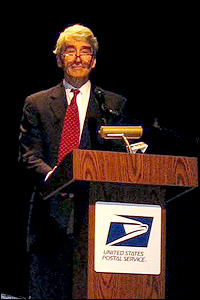
*
On May 12, 2010, the Katharine Hepburn Cultural Arts Center in Old Saybrook, CT, was filled to capacity. Neither the morning's unseasonably bracing temperature nor the gloomy downpour stood much of a chance against the glow emanating from inside the house, as friends, family, colleagues and fans gathered to remember the actress with warmth, affection and good humor.
The occasion for this love-fest was the United States Postal Service's dedication of a Katharine Hepburn 44-cent postage stamp on what would have been the actress' 103rd birthday. The stamp, the 16th in the USPS' Legends of Hollywood stamp series, was designed by Derry Noyes and features an elegant black and white publicity photo taken by legendary Hollywood photographer Clarence S. Bull to promote Hepburn's 1942 picture "Woman of the Year." As of May 12, it became available for sale at post offices across the country.
The setting for the event — in this town at the mouth of the Connecticut River — was ideal. Hepburn was only five years old when her parents built a summer home in Fenwick, a borough of Old Saybrook. It's the haven to which she always retreated throughout her long life, and it's the place where that celebrated life came to an end seven years ago.
Perhaps no other star born in that era of glittering Hollywood legends of the 1930s carved out as unique a spot as Katharine Hepburn, who ultimately became as admired for her life as for her art. Her rocket-fueled professional ascent (which was not devoid of occasional stomach-churning turbulence) was equaled by a personal mode of conduct and strength of character that made her an inspiration to generations of women.
So, as she had from the moment of her first close-up in 1932's "A Bill of Divorcement," Hepburn took center stage once more, this time at the theatre named in her honor, in the form of an oversized facsimile of her stamp that was unveiled to a packed house by actor Sam Waterston, director Anthony Harvey, Postmaster General John E. Potter and the Hepburn theatre's executive director Chuck Still. Potter praised Hepburn as "a role model for women who chose to live life on their own terms," and Still used the forum to acknowledge the residents of Old Saybrook, saying that Hepburn's choice to live there, when she could have lived anywhere in the world, spoke volumes about the them.
 |
||
| Sam Waterston at the unveiling |
||
| photo by Judy Samelson |
Harvey, who directed Hepburn in four pictures, including "The Lion in Winter," for which she won the third of her record four Best Actress Oscars and for which he received a Directors Guild Award, was also a close friend of the actress. He spoke about how funny she was and by way of example recounted the time she was shooting the TV movie "Love Among the Ruins" in London. As she tried to get to sleep one night she heard an annoying flapping sound outside. She looked out the window and "saw in the distance some kind of flag. She went down to the kitchen, got a knife, climbed several rooftops like Mary Poppins, cut the flag — which, by the way, was the American Embassy" and returned to what she thought was her apartment, only to realize, when the elderly inhabitant had let out a shriek, that she had climbed back into the wrong window.
Harvey, whose "Lion in Winter" cast included the film debuts of several actors, Anthony Hopkins and Timothy Dalton among them, concurred with Waterston about Hepburn's ability to make young actors "feel within the first week part of a family so that all that knee trembling thing that actors feel vanished. . . . She had a real gift for making people relaxed" — to which Waterston interjected, "And once you were comfortable, she would grab you by the collar and say, 'We need everything from you!'"
What also spoke volumes about Hepburn personally of course, was the fact that many who knew her — both family and friends — were in the audience, applauding alongside her fans. Among Hepburn intimates at the dedication were Ellsworth Grant, her brother-in-law, historian and former Mayor of West Hartford; her nephew, artist Mundy Hepburn; Norah Considine-Moore, who worked for Hepburn for 30 years; her daughter Eileen Considine-Meara, whose book "At Home with Kate" is a warm account of growing up around the Hepburn household; artist Joan Levy Hepburn; and producer–writer John Dayton, who worked with Hepburn on three of her late-in-life television movies.
All the participants, including Waterston, thought that Hepburn would have enjoyed the event as much for the honor as for its brevity. "Well it couldn't be more appropriate, really, could it," Waterston said. "It's great to have the memory of this wonderful actress commemorated in this way."
But perhaps Mundy Hepburn's take on the affair best captured the mood of the morning and what his aunt's reaction might have been. "It's really nice," he told reporters. "It's not just some fake ceremony, which I thought it was going to be. It's real and it's nice. I can definitely feel her being tickled pink. . . . I can just see her up on her cloud, looking down laughing, going, 'Oh, my! Look at that!'"
(Judy Samelson is a regular contributor and writes Playbill.com's Shelf Life column. Write her at [email protected].)











